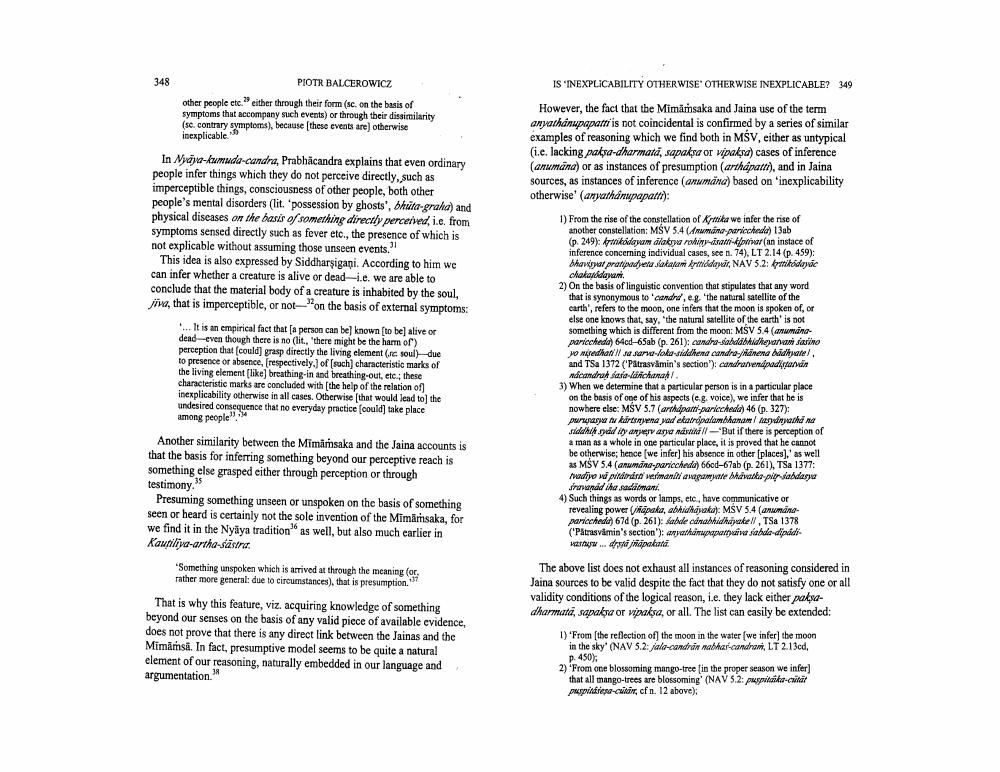Book Title: Is Inexplicability Otherwise Otherwise Inexplicable Author(s): Piotr Balcerowicz Publisher: Piotr Balcerowicz View full book textPage 4
________________ 348 IS INEXPLICABILITY OTHERWISE OTHERWISE INEXPLICABLE? 349 PIOTR BALCEROWICZ other people etc. either through their form (sc. on the basis of symptoms that accompany such events) or through their dissimilarity (SC. contrary symptoms), because these events are otherwise inexplicable In Maya-Kumuda-candra, Prabhacandra explains that even ordinary people infer things which they do not perceive directly, such as imperceptible things, consciousness of other people, both other people's mental disorders (lit.'possession by ghosts', bragraha) and physical diseases on the basis of something directly perceind, i.e. from symptoms sensed directly such as fever etc., the presence of which is not explicable without assuming those unseen events." This idea is also expressed by Siddharsigani. According to him we can infer whether a creature is alive or dead i.e. we are able to conclude that the material body of a creature is inhabited by the soul, jing, that is imperceptible, or not on the basis of external symptoms: .... It is an empirical fact that sa person can be known to be alive or dead-even though there is no (lit, there might be the harm of) perception that could) grasp directly the living elements soul) due to presence or absence, respectively) of (such) characteristic marks of the living element (like) breathing in and breathing-out, etc. these characteristic marks are concluded with the help of the relation of inexplicability otherwise in all cases. Otherwise that would lead to the undesired consequence that no everyday practice (could take place among people".. However, the fact that the Mimamsaka and Jaina use of the term anyathanupapati is not coincidental is confirmed by a series of similar examples of reasoning which we find both in MŚV, either as untypical (i.e. lacking paksa-dharmata, sapaksa or vipaksa) cases of inference (anumana) or as instances of presumption (arthápatti), and in Jaina sources, as instances of inference (anumana) based on 'inexplicability otherwise' (amatdapatti): 1) From the rise of the constellation of m e we infer the rise of another constellation: MSV 54 (A mina panicchada) 13ab (249): itu dilakurdidatti- k uran instace of inference concerning individual cases, see n. 74), LT 2.14 (p. 459): bhavour pratat fakatuwiddo, NAV 5.2: pide chaladiyயா. 2) On the basis of linguistic convention that stipulates that any word that is synonymous to candid, eg the natural satellite of the carth', refers to the moon, one infers that the moon is spoken of, or else one knows that, say, 'the natural satellite of the earth is not something which is different from the moon: MSV 5.4 (anumangpariechnd) 64od-65ab (p. 261): candra-saddi tidheanan sasino wredhan/a sare fotodden candra fiánena budhatel. and TSa 1372 (Patrasvamin's section"): cadranendradrandin Mdcandrat Basie dichanah/. 3) When we determine that a particular person is in a particular place on the basis of one of his aspects (eg. voice), we infer that he is nowhere else: MSV 5.7 (artpam parieched) 46 (p. 327): purwa karona yad etapalamdanam masydnyarha na siddhet piddiy aruan ndall "But if there is perception of a man as a whole in one particular place, it is proved that he cannot be otherwise; hence (we infer) his absence in other places],' as well as MSV 5.4 (arumine parlech ) 66cd-67ab (p. 261), TSa 1377: nudijo v prvemasih a matebildaska pisadanu mund te domani 4) Such things as words or lamps, etc., have communicative or revealing powerpaksa dilaka): MSV 5.4 (anumisperico ) 670 (p. 261): lahen d uell, TSa 1378 ('Patrasamin's section"): areshauppafu sinhala-dipadidi w...rstaka Another similarity between the Mimarnsaka and the Jaina accounts is that the basis for inferring something beyond our perceptive reach is something else grasped either through perception or through testimony." Presuming something unseen or unspoken on the basis of something seen or heard is certainly not the sole invention of the Mimarsaka, for we find it in the Nyaya tradition as well, but also much earlier in Kaunilovaartha-slastra. "Something unspoken which is arrived at through the meaning for rather more general: due to circumstances), that is presumption That is why this feature, viz acquiring knowledge of something beyond our senses on the basis of any valid piece of available evidence, does not prove that there is any direct link between the Jainas and the Mimarisa. In fact, presumptive model seems to be quite a natural element of our reasoning, naturally embedded in our language and argumentation 18 The above list does not exhaust all instances of reasoning considered in Jaina sources to be valid despite the fact that they do not satisfy one or all validity conditions of the logical reason, i.e. they lack either paksa dharmata, sapaks or vipaksa, or all. The list can easily be extended: 1) 'From the reflection of the moon in the water (we infer) the moon in the sky' (NAV 5.2: jala-candran nabarcandhani, LT 2.13cd, p. 450): 2) From one blossoming mango-tree in the proper season we infer) that all mango-trees are blossoming' (NAV 5.2: puguitaita-cital paspire-critin, of n. 12 above),Page Navigation
1 2 3 4 5 6 7 8 9 10 11 12 13 14 15 16 17 18 19 20
